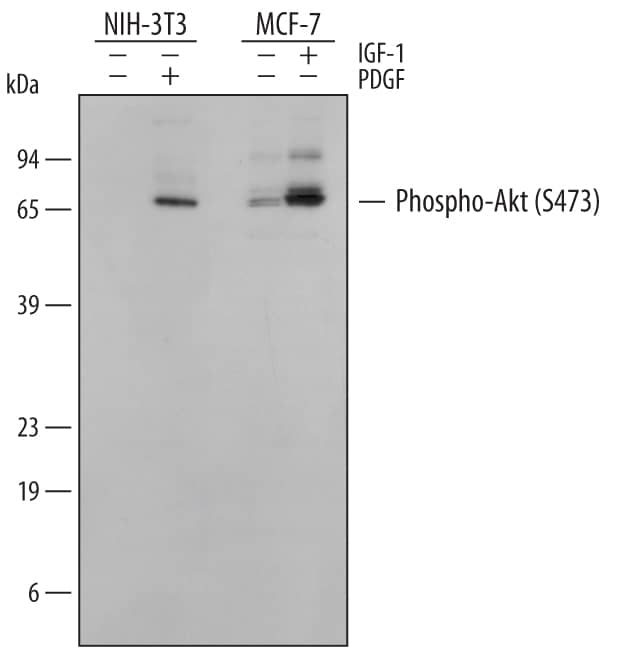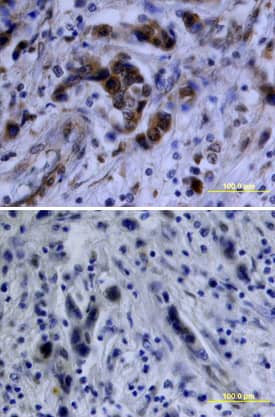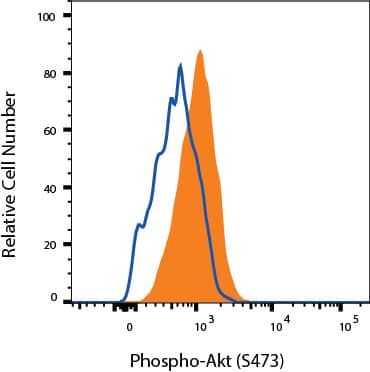Akt1 (pS473) Polyclonal / Unconjugated /
Akt1 (pS473) Polyclonal / Unconjugated /
Product Details
| Supplier | R&D Systems | |
|---|---|---|
| Catalog #: | AF887-SP (View supplier product page) | |
| Size | 25 μg | |
| Price | $169.00 | |
| Antigen | Akt1 (pS473) | |
| Clone | ||
| Host | Rabbit | |
| Isotype | IgG | |
| Conjugate | Unconjugated | |
| Target Species | Human, Mouse, Primate, Rat | |
| Applications | WB, IHC, CyTOF, IHC-P, IHC-Fr, ICFC | |
| Description | Human/Mouse/Rat Phospho-Akt (S473) Pan Specific Antibody Intracellular Flow Cytometry = ICFC |
About Akt1 (pS473) and Purified
| Akt1 (pS473) | This gene encodes one of the three members of the human AKT serine-threonine protein kinase family which are often referred to as protein kinase B alpha, beta, and gamma. These highly similar AKT proteins all have an N-terminal pleckstrin homology domain, a serine/threonine-specific kinase domain and a C-terminal regulatory domain. These proteins are phosphorylated by phosphoinositide 3-kinase (PI3K). AKT/PI3K forms a key component of many signalling pathways that involve the binding of membrane-bound ligands such as receptor tyrosine kinases, G-protein coupled receptors, and integrin-linked kinase. These AKT proteins therefore regulate a wide variety of cellular functions including cell proliferation, survival, metabolism, and angiogenesis in both normal and malignant cells. AKT proteins are recruited to the cell membrane by phosphatidylinositol 3,4,5-trisphosphate (PIP3) after phosphorylation of phosphatidylinositol 4,5-bisphosphate (PIP2) by PI3K. Subsequent phosphorylation of both threonine residue 308 and serine residue 473 is required for full activation of the AKT1 protein encoded by this gene. Phosphorylation of additional residues also occurs, for example, in response to insulin growth factor-1 and epidermal growth factor. Protein phosphatases act as negative regulators of AKT proteins by dephosphorylating AKT or PIP3. The PI3K/AKT signalling pathway is crucial for tumor cell survival. Survival factors can suppress apoptosis in a transcription-independent manner by activating AKT1 which then phosphorylates and inactivates components of the apoptotic machinery. AKT proteins also participate in the mammalian target of rapamycin (mTOR) signalling pathway which controls the assembly of the eukaryotic translation initiation factor 4F (eIF4E) complex and this pathway, in addition to responding to extracellular signals from growth factors and cytokines, is disregulated in many cancers. Mutations in this gene are associated with multiple types of cancer and excessive tissue growth including Proteus syndrome and Cowden syndrome 6, and breast, colorectal, and ovarian cancers. Multiple alternatively spliced transcript variants have been found for this gene. [provided by RefSeq, Jul 2020] |
|---|
Images

|
Detection of Mouse and Human Phospho-Akt (S473) Pan Specific by Western Blot. Western blot shows lysates of NIH-3T3 mouse embryonic fibroblast cell line untreated (-) or treated (+) with 100 ng/mL Human PDGF (Catalog # 120-HD) for 15 minutes and MCF-7 human breast cancer cell line untreated or treated with 100 ng/mL Recombinant Human IGF-1 (Catalog # 291-G1) for 15 minutes. PVDF membrane was probed with 0.5 µg/mL of Rabbit Anti-Human/Mouse/Rat Phospho-Akt (S473) Pan Specific Antigen Affinity-purified Polyclonal Antibody (Catalog # AF887), followed by HRP-conjugated Anti-Rabbit IgG Secondary Antibody (Catalog # HAF008). A specific band was detected for Phospho-Akt (S473) Pan Specific at approximately 60 kDa (as indicated). This experiment was conducted under reducing conditions and using Immunoblot Buffer Group 1. |
|

|
Akt in Human Breast Cancer Tissue. Akt phosphorylated at S473 was detected in immersion fixed paraffin-embedded sections of human breast cancer tissue using Rabbit Anti-Human/Mouse/Rat Phospho-Akt (S473) Antigen Affinity-purified Polyclonal Antibody (Catalog # AF887) at 10 µg/mL overnight at 4 °C. Tissue was stained using the Anti-Rabbit HRP-DAB Cell & Tissue Staining Kit (brown; Catalog # CTS005) and counterstained with hematoxylin (blue). Lower panel shows a lack of labeling if primary antibodies are omitted and tissue is stained only with secondary antibody followed by incubation with detection reagents. View our protocol for Chromogenic IHC Staining of Paraffin-embedded Tissue Sections. |
|

|
Detection of Human Phospho-Akt (S473) by Simple WesternTM. Simple Western lane view shows lysates of MCF-7 human breast cancer cell line and A549 human lung carcinoma cell line untreated (-) or treated (+) with 100 ng/mL Recombinant Human IGF-I (Catalog # 291-G1) for 15 minutes, loaded at 0.2 mg/mL. A specific band was detected for Phospho-Akt (S473) at approximately 60 kDa (as indicated) using 5 µg/mL of Rabbit Anti-Human/Mouse/Rat Phospho-Akt (S473) Pan Specific Antigen Affinity-purified Polyclonal Antibody (Catalog # AF887). This experiment was conducted under reducing conditions and using the 12-230 kDa separation system. |
|

|
Detection of Phospho-Akt (S473) in IGF-1-treated MCF-7 cells by Flow Cytometry. Serum-starved MCF-7 human breast cancer cells were unstimulated (light orange filled histogram) or activated with 100 ng/mL Recombinant human IGF-1 (Catalog # 291-G1, dark orange filled histogram) for 15 minutes, then stained with Rabbit Anti-Human/Mouse/Rat Phospho-Akt (S473) Antigen Affinity-purified Polyclonal Antibody (Catalog # AF887) or control antibody (Catalog # AB-105-C, open histogram), followed by Allophycocyanin-conjugated Anti-Rabbit IgG Secondary Antibody (Catalog # F0111). To facilitate intracellular staining, cells were fixed with paraformaldehyde and permeabilized with saponin. |
Citations
Reviews & Ratings
Purified Excitation and Emission Spectra
Supplier Page



